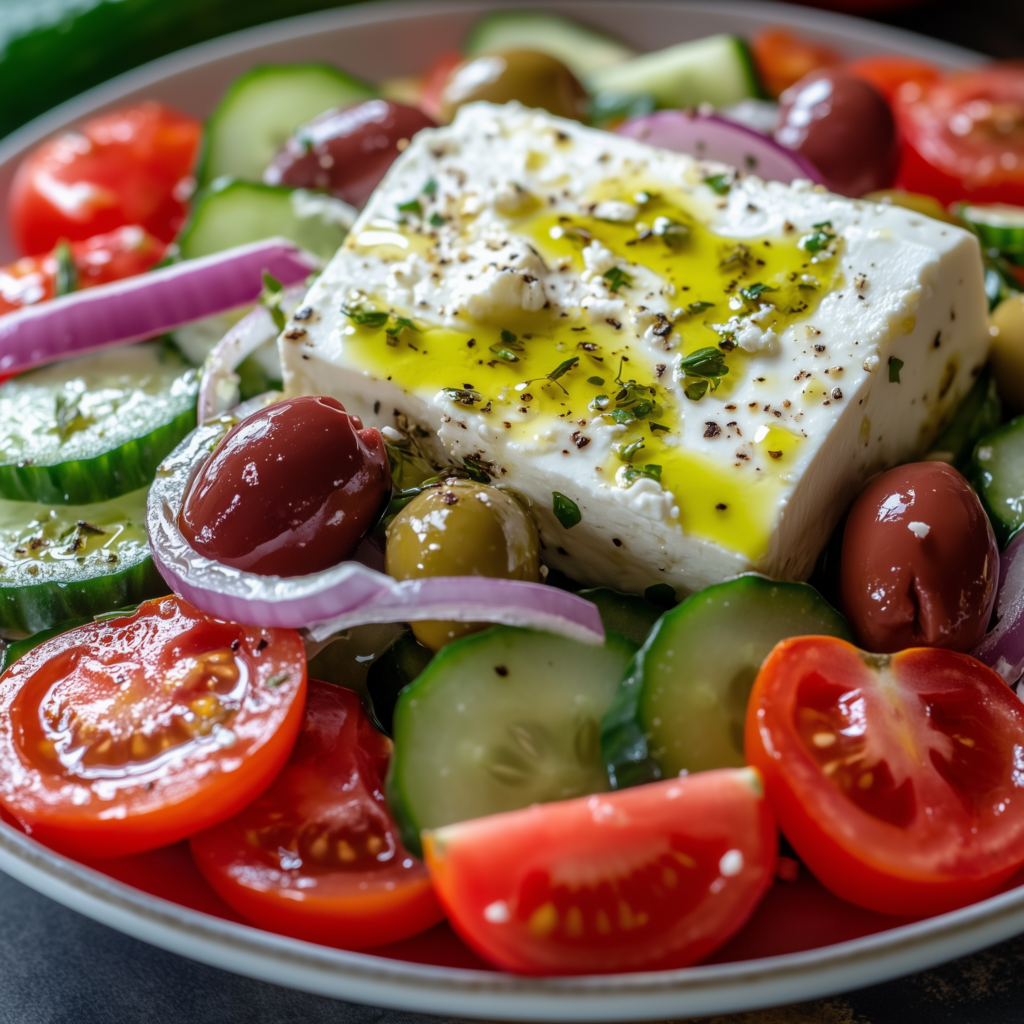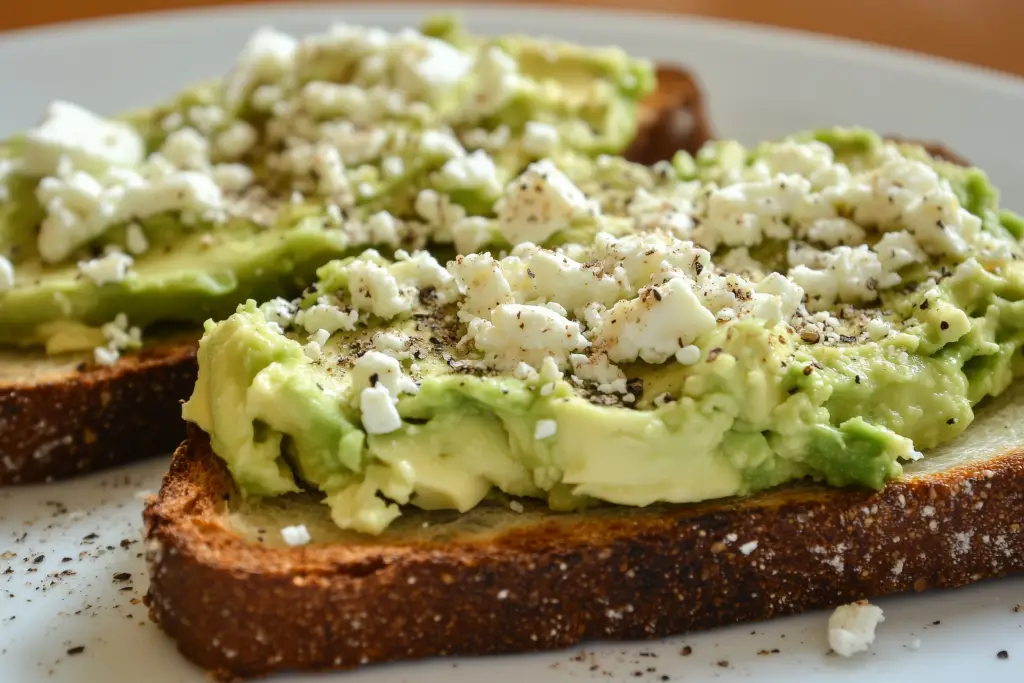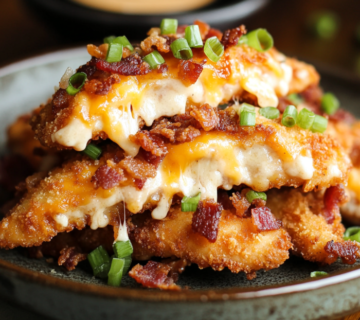In today’s fast-paced world, finding time to prepare healthy meals can be a challenge. However, eating well doesn’t have to be time-consuming. Here are ten quick and healthy recipes that are perfect for a busy lifestyle. Each recipe includes a historical tidbit, detailed ingredients, step-by-step instructions, and tips to make it special.
1. Greek Salad (Horiatiki)

Historical Background: The Greek salad, or Horiatiki, has been a staple of Greek cuisine for centuries. It originated in rural villages, where fresh vegetables and olive oil were readily available.
Ingredients:
- 2 large tomatoes (chopped)
- 1 cucumber (sliced)
- 1 red onion (thinly sliced)
- 1 green bell pepper (sliced)
- 100g feta cheese (crumbled)
- 10 Kalamata olives
- 2 tablespoons olive oil
- 1 teaspoon dried oregano
- Salt and pepper to taste
Instructions:
- Combine the tomatoes, cucumber, onion, and bell pepper in a large bowl.
- Top with feta cheese and olives.
- Drizzle with olive oil and sprinkle with oregano, salt, and pepper.
Make It Special: Add a squeeze of fresh lemon juice and serve with warm pita bread for a refreshing and satisfying meal.
2. Japanese Miso Soup

Historical Background: Miso soup, a traditional Japanese dish, dates back to the 7th century. It is made with fermented soybean paste and is a staple of Japanese breakfasts.
Ingredients:
- 1 liter dashi stock (or vegetable broth)
- 3 tablespoons miso paste
- 100g tofu (cubed)
- 2 green onions (sliced)
- 1 sheet nori (cut into strips)
Instructions:
- Heat the dashi stock in a pot until simmering.
- Dissolve the miso paste in the stock.
- Add the tofu and green onions, then simmer for 5 minutes.
- Garnish with nori strips before serving.
Make It Special: Add shiitake mushrooms or baby spinach for extra flavor and nutrients.
3. Mexican Avocado Toast

Historical Background: Avocado toast has become a global phenomenon, but its roots can be traced to Mexico, where avocados have been cultivated for thousands of years.
Ingredients:
- 2 slices whole-grain bread
- 1 ripe avocado
- 1 lime (juiced)
- 1/2 teaspoon chili flakes
- Salt and pepper to taste
- 1 radish (thinly sliced)
Instructions:
- Toast the bread until golden.
- Mash the avocado with lime juice, chili flakes, salt, and pepper.
- Spread the avocado mixture on the toast and top with radish slices.
Make It Special: Add a poached egg or a sprinkle of cotija cheese for a protein boost.
4. Indian Chana Masala

Historical Background: Chana masala, a spicy chickpea curry, originated in North India and has been a popular street food and home-cooked meal for generations.
Ingredients:
- 1 can chickpeas (drained and rinsed)
- 1 onion (chopped)
- 2 tomatoes (chopped)
- 2 garlic cloves (minced)
- 1 teaspoon ginger (grated)
- 1 teaspoon cumin seeds
- 1 teaspoon turmeric
- 1 teaspoon garam masala
- 1 tablespoon olive oil
- Fresh cilantro for garnish
Instructions:
- Heat the oil in a pan and sauté the cumin seeds until fragrant.
- Add the onion, garlic, and ginger, and cook until soft.
- Stir in the tomatoes, turmeric, and garam masala, then add the chickpeas.
- Simmer for 10 minutes and garnish with cilantro.
Make It Special: Serve with steamed basmati rice or warm naan bread.
5. Italian Caprese Salad

Historical Background: The Caprese salad, featuring tomatoes, mozzarella, and basil, was created on the island of Capri in the 1950s to showcase the colors of the Italian flag.
Ingredients:
- 2 large tomatoes (sliced)
- 200g fresh mozzarella (sliced)
- Fresh basil leaves
- 2 tablespoons olive oil
- 1 tablespoon balsamic glaze
- Salt and pepper to taste
Instructions:
- Arrange the tomato and mozzarella slices on a plate, alternating them.
- Tuck basil leaves between the slices.
- Drizzle with olive oil and balsamic glaze, then season with salt and pepper.
Make It Special: Add a sprinkle of sea salt or a few drops of truffle oil for a gourmet touch.
6. Vietnamese Spring Rolls

Historical Background: Vietnamese spring rolls, or Goi Cuon, originated in the Mekong Delta and are a lighter, fresher alternative to fried spring rolls.
Ingredients:
- 8 rice paper wrappers
- 100g rice vermicelli (cooked)
- 1 carrot (julienned)
- 1 cucumber (julienned)
- 100g shrimp (cooked and peeled)
- Fresh mint and cilantro leaves
- Peanut dipping sauce
Instructions:
- Soak the rice paper wrappers in warm water until soft.
- Place a small amount of vermicelli, carrot, cucumber, shrimp, and herbs in the center of each wrapper.
- Fold the sides over the filling and roll tightly.
- Serve with peanut dipping sauce.
Make It Special: Add thin slices of avocado or mango for a tropical twist.
7. Middle Eastern Hummus

Historical Background: Hummus, a creamy dip made from chickpeas and tahini, has been a staple in Middle Eastern cuisine for centuries.
Ingredients:
- 1 can chickpeas (drained and rinsed)
- 2 tablespoons tahini
- 2 garlic cloves
- 1 lemon (juiced)
- 2 tablespoons olive oil
- Salt to taste
Instructions:
- Blend the chickpeas, tahini, garlic, lemon juice, and olive oil in a food processor until smooth.
- Season with salt and drizzle with olive oil before serving.
Make It Special: Top with paprika, chopped parsley, or a sprinkle of sumac for added flavor.
8. Thai Green Papaya Salad (Som Tum)

Historical Background: Som Tum, a spicy and tangy salad, originated in Thailand and is a popular street food. It is known for its bold flavors and refreshing crunch.
Ingredients:
- 1 green papaya (shredded)
- 1 carrot (shredded)
- 2 green beans (chopped)
- 1 tomato (chopped)
- 1 tablespoon fish sauce
- 1 lime (juiced)
- 1 teaspoon sugar
- 1 chili (chopped)
- 2 tablespoons roasted peanuts
Instructions:
- Combine the papaya, carrot, green beans, and tomato in a bowl.
- Mix the fish sauce, lime juice, sugar, and chili in a small bowl.
- Toss the dressing with the salad and top with roasted peanuts.
Make It Special: Add grilled shrimp or chicken for a protein-packed meal.
9. Mediterranean Quinoa Bowl

Historical Background: Quinoa, a nutrient-rich grain, has been cultivated in the Andes for thousands of years. This bowl combines Mediterranean flavors for a quick and healthy meal.
Ingredients:
- 1 cup cooked quinoa
- 1 cucumber (diced)
- 1 tomato (diced)
- 100g feta cheese (crumbled)
- 10 Kalamata olives
- 2 tablespoons olive oil
- 1 teaspoon dried oregano
Instructions:
- Combine the quinoa, cucumber, tomato, feta, and olives in a bowl.
- Drizzle with olive oil and sprinkle with oregano.
Make It Special: Add a dollop of tzatziki or hummus for extra creaminess.
10. American Smoothie Bowl

Historical Background: Smoothie bowls became popular in the U.S. in the 2010s as a way to enjoy a thick, nutrient-packed smoothie with a variety of toppings.
Ingredients:
- 1 frozen banana
- 1/2 cup frozen berries
- 1/2 cup almond milk
- 1 tablespoon chia seeds
- Toppings: granola, fresh fruit, coconut flakes, nuts
Instructions:
- Blend the banana, berries, and almond milk until smooth.
- Pour into a bowl and top with chia seeds, granola, fresh fruit, and coconut flakes.
Make It Special: Use colorful toppings like edible flowers or pomegranate seeds for a visually stunning bowl.
The Importance of Meal Planning for a Busy Lifestyle
In today’s fast-paced world, maintaining a healthy diet can feel like an uphill battle, especially when juggling work, family, and social commitments. However, with a little foresight and organization, eating well doesn’t have to be time-consuming or stressful. Meal planning is a powerful tool that can help you stay on track with your health goals while saving time and money. Here’s how you can incorporate meal planning into your busy lifestyle and make the most of the quick and healthy recipes shared in this article.
Why Meal Planning Matters
Meal planning is more than just a trend—it’s a practical strategy that can transform the way you eat. By taking the time to plan your meals in advance, you can:
- Save Time: Knowing what you’re going to eat eliminates the daily stress of deciding what to cook.
- Reduce Food Waste: Planning meals helps you buy only what you need, reducing the likelihood of unused ingredients going bad.
- Stay Consistent: Having a plan makes it easier to stick to healthy eating habits, even on your busiest days.
- Save Money: Avoiding last-minute takeout or convenience foods can significantly cut down on your food expenses.
How to Get Started with Meal Planning
- Set Aside Time for Planning: Dedicate 30 minutes each week to plan your meals. Use this time to browse recipes, create a shopping list, and prep ingredients.
- Choose Recipes Wisely: Opt for recipes that are quick, easy, and use overlapping ingredients. The recipes in this article are perfect for this purpose, as they require minimal prep and cooking time.
- Batch Cooking: Prepare larger quantities of meals like soups, stews, or grain bowls that can be stored in the fridge or freezer for later use.
- Prep Ahead: Wash and chop vegetables, cook grains, or marinate proteins in advance to streamline your cooking process during the week.
Tips for Making Meal Planning Work for You
- Keep It Simple: Start with a few basic recipes and gradually expand your repertoire. Overcomplicating your meals can lead to burnout.
- Use Versatile Ingredients: Stock your pantry with staples like quinoa, canned beans, olive oil, and spices that can be used in multiple dishes.
- Incorporate Variety: Rotate different cuisines and flavors to keep your meals exciting. For example, alternate between Mediterranean, Asian, and Mexican-inspired dishes.
- Stay Flexible: Life can be unpredictable, so it’s okay to swap meals or adjust your plan as needed.
Making Healthy Eating Special
Even with a busy schedule, you can make your meals feel special and enjoyable. Here are a few ideas:
- Presentation Matters: Take a few extra minutes to plate your food beautifully. A well-presented meal can make even the simplest dish feel luxurious.
- Add Personal Touches: Customize your meals with your favorite herbs, spices, or toppings. For example, sprinkle fresh cilantro on your chana masala or add a drizzle of honey to your smoothie bowl.
- Share the Experience: Involve your family or friends in meal prep. Cooking together can make the process more fun and rewarding.
By incorporating meal planning into your routine, you can enjoy the benefits of healthy eating without sacrificing time or convenience. The recipes in this article are designed to fit seamlessly into a busy lifestyle, offering a balance of nutrition, flavor, and ease. With a little planning and creativity, you can make every meal a step toward a healthier, happier you.




No comment